This article is the primer for our series on how the COVID-19 pandemic and its associated lockdowns have impacted the livelihoods of three Indian transhumant pastoralist communities—the Van Gujjars, the Bakarwals, and the Raikas. Click here for part two, on the Van-Gujjar community, and here for part three on the Gujjar-Bakarwals.
Editor’s note: this article contains a photograph of a deceased buffalo. Reader’s discretion is advised.
Nomadic pastoralism—or transhumance—is understood as a pattern of movement and migration practised by nomadic pastoral communities in mountainous regions. With fixed routes and timetables to carry forth their livelihood, these communities move across seasons, quite literally, in search of greener common pastures to graze on.
Today, nomadic pastoralism as a livelihood and an identity is considered backward and without prospects by the State and the market. Time and again, transhumance as a way of life has faced assaults from the notions of ‘modernity’ and ‘development’ prescribed within India’s neocolonial socio-legal framework for forestry, land use, and wildlife protection.
This existential backlash has been acutely felt by the two major nomadic pastoralists of the Himalayas—the Bakarwals of Jammu and Kashmir, and the Van Gujjars of Uttarakhand.

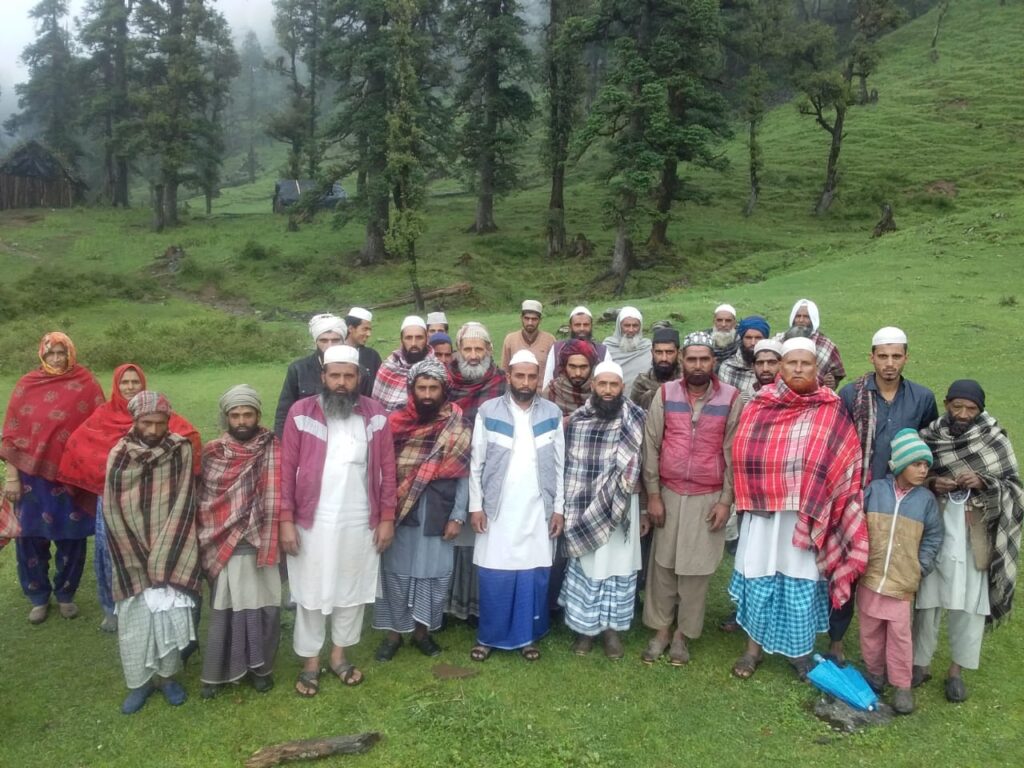
During the colonial period, access to commons in a tappar (riverine plain), beat, or range was gradually institutionalised grazing permits issued by the Forest Department. These permits determined the locations of the summer and winter homesteads these nomads resided at, in between their seasonal migration [1]. “Yeh Gujjar ka permit hi uske ghumantu pashupalan ke kaam ko ek astitva de raha hai,” exclaims Yakoob Ali, a Van Gujjar, in Hindi. Ali believes the permits are crucial to ensuring the Van Gujjar community’s claim over the bugyals—or pastures—for grazing and residing upon. Ali himself migrates to Sankri range in Uttarakhand’s Govind Pashu Vihar National Park every summer.
Now, however, nomadic life is being viewed with increasing hostility by the State—via the Forest Department—and its settled constituents. There are continuous efforts by these agencies to ‘civilize’ pastoralist communities towards adopting settled lives, by denying them access to their common pastures within forests. The COVID-19 pandemic and its ensuing lockdowns have fuelled this structural discontent, with a slew of specific policy measures having devastating impacts on the transhumance economy. The restrictions imposed since lockdown, for example, have led to the deaths of numerous livestock owned by the Van Gujjars and Bakarwals, greatly diminished their productivity, created barriers to access the markets, as well as gravely impacted their incomes.
Tired of the innumerable instances of harassment, many nomadic pastoralists have begun to view the practice negatively. Large numbers now believe that only equitable resettlement and availing modern education will ensure their survival amidst a neoliberal state polity.
“We Gujjars must also move ahead through education or businesses beyond pastoralism,” says Shammi Bhadana, a Van Gujjar from Noki Dasowali, in Uttarakhand’s Haridwar district. “This practice is no longer seen as economically viable despite tangible ecological benefits.”
The first three parts of this series delve into the lived experiences of the Bakarwals and Van Gujjars and the commonalities and divergences between them that threaten their intrinsically transhumant livelihoods and identities. However, to do that, we must first shed light on the civilizational nature of “legitimate” state policy towards nomadic pastoralists. How do these Himalayan nomads plan to protect themselves amidst this onslaught?
Why Is Pastoralists’ Labour Considered ‘Non-essential’?
Even prior to the pandemic, the combination of law, bureaucracy, and rights shaped by social sanction—all of which are influenced by India’s neoliberal State—come together to marginalise, if not undermine, the labour of the Bakarwals and the Van Gujjars. Their labour consists of livestock rearing and grazing—which is difficult to practice given the State’s attempts to sever their relationship with common pasture lands.
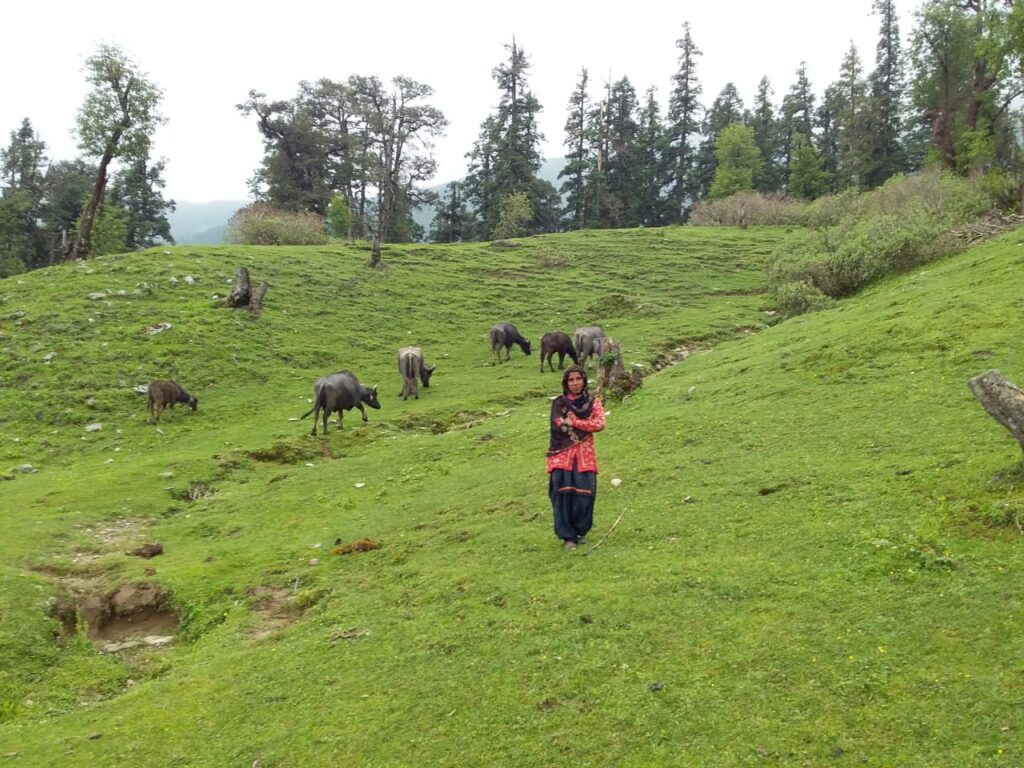
The policy-led exclusion of transhumant communities and their cattle from open areas specifically stems from the implementation of Wildlife Protection Laws and the setting up of the Protected Area Network in the 1980s. Both frameworks are based on a colonial view of forests as a resource to be protected for exploitation by a few, rather than a symbiotic habitat to be utilised by a variety of stakeholders.
These stringent policies—that pursue what is often described as “fortress conservation”—have been misused to empower the Forest Department to conduct arbitrary eviction exercises against pastoralists, without setting forth an equitable resettlement and rehabilitation programme based on their consent.
Even when customary access to pastures was recognised under the relatively progressive and democratic Forest Rights Act, 2006 (FRA), its implementation was stifled by bureaucratic interpretation. Nodal agencies—such as the Forest Department—displayed a lack of political will to facilitate the inclusion of nomads into local governance regimes in the forests.
Himdhara, an environment collective, based in Himachal Pradesh has urged members of the High Powered Committee on land laws formed by the state government in 2020, to push for the just and speedy implementation of the #ForestRightsAct 2006 in #HimachalPradesh.
— Endangered Himalaya (@EndangeredHimal) July 20, 2021
This heavily bureaucratic forest governance regime in independent India indicates that transhumant migration across seasons, and the implicit access to pastures across regions, was never considered a right by the State. Instead, it is viewed as an administrative concession—one that is dependent on the renewal of grazing permits, and the payment of fees by the community’s lambardar (head of the family). Grazing permits, valid every six months when they chose to migrate, allow the grazing of only certain cattle based on fixed rates in specific compartments of the forests.
The attitude of the Forest Department towards livestock and grazing—and the quick expiry of the permits themselves—has ultimately exhibited the State’s keenness to eventually ground these seasonal nomads. By adopting the carrot and stick approach, it convinces or coerces these populations into becoming gradually sedentary [2]. In the eyes of the State, a subsistence based livelihood strategy rooted in rotational migration and grazing is clearly no longer viable, without any credence to its ecological need within forests.
To that end, the transhumant way of life is seen as rebellious by the State. As per the political economy of colonial forestry, it is unproductive and incapable of generating taxes and revenue [3]—thus rendering the labour of these communities inconsequential and ‘non-essential’. Their milk economy is subsistence-based and relies upon access to natural resources such as open pastures—making them a populace that operates outside the sphere of capital accumulation, which the neoliberal state is heavily dependent upon [4]. The treatment of Van Gujjars and Bakarwals during COVID-19—which hinges on their socio-economic marginalisation in modern India—is emblematic of majoritarian attitudes towards pastoralists.
For example, the State’s unwillingness to secure the livelihoods of nomadic pastoralists during the pandemic has led to lower productivity amongst lactating buffaloes. This, combined with restricted access to pasture land and increased debts from the purchase of fodder and feed, has impacted local supply chains, especially those for milk—an “essential commodity.”
The State’s lockdown policy raises the question of who determines what work is considered essential and how this value is determined. While transhumant populations are marginalised, the benefits of a stable domicile are simultaneously projected by the State as key to availing access to electricity, water, education, and healthcare as a citizen—think of the numerous “permanent residence” proofs linked to our government documents.
For the Bakarwals, “the constant sense of marginalisation and step-motherly treatment as ‘Bakarwals from Kashmir’ has made them wary of State institutions,” says Ch. Hussain from Thanamandi, in Jammu and Kashmir’s Rajouri district. Hussain’s comments highlight how historically these communities did not maintain much contact with urban settings—a disadvantage when the pandemic’s many lockdowns came into play.
How Did COVID-19 Worsen Discrimination Against Pastoralists?
The policies designed to tackle India’s COVID-19 outbreak have put the practice of transhumance under stress. Urban policy administrators and social health experts failed to recognise that physical distancing and avoiding concentrated habitations—the cornerstones of COVID-19 containment—are already intrinsic to pastoralism. This lack of foresight produced delays in obtaining State permissions to migrate for several Van Gujjars, forcing them to toe the line of an urbanised COVID-19 policy, with devastating consequences.
Roshan Deen, who would otherwise migrate to Kukodiya bugyals in Uttarkashi district in the summer, decided to stay put in his winter homestead this year, shifting his migration route for his buffaloes to the nearby pastures of Khadar in Bijnor district. “I chose to send my buffaloes to Khadar since the transit is a short 3-4 days,” says Deen. “While the threat of violating the lockdown is less as we traverse along the riverbanks of the Ganga, the river floods quite swiftly putting both our buffaloes and our own life at risk.” However, for the majority of the Van Gujjars who stayed back in their winter homesteads in Haridwar, Dehradun, and Pauri districts during the summer, the pastures on the foothills began wilting with low access to water and grass, pushing the livestock to the brink of starvation, and in some cases, even death.
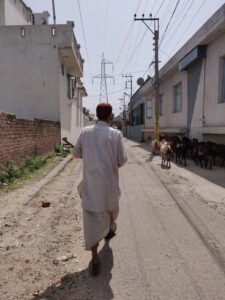
Similarly, Bakarwals who had traveled all the way from Kokernag in Kashmir—an arduous 200 kilometre journey through the mountains—were forced to stay back in Jammu and find alternate sources of income. Many sold most of their flock of goats during the lockdown. The community now faces a mound of debt due to these distress sales—threatening intergenerational economic impacts as well.s
The COVID-19 lockdown has also given settled locals in both Uttarakhand and Jammu and Kashmir an opportunity to collude with the Forest Department to deny pastoralists access to graze in village forests and common grazing lands. Citing COVID-19, the locals have put in restrictions that prevent these nomadic pastoralists from purchasing fodder at fair prices, and have been restricted from accessing farmlands to collect it too.
This idea of fencing off forests from ‘outsiders’ stems from the principles of private property and development for profit. These systems are sanctified by local pahadi populations—or settled populations from Uttarakhand—whose customary communitarian beliefs view nomads as threats to their hegemony over land and resources. The seeds of discontent between settlers and transhumants were sown by the Forest Department’s grazing policies and permits, which were issued to fuel the perception against transhumants as threats to the sustainable use of village commons. None of the Working Plans of the Forest Department have granted these nomads any rights and concessions over grazing lands within the forest tracts—like those for local village graziers—but merely exacted a higher fee from them for grazing upon open pastures.
In recent times, the stigmatization of their Muslim identity specifically threatens their lives and livelihoods as professional grazers, by magnifying the existing discriminatory attitudes they face from settled communities. For example, the media demonisation of the Tablighi Jamaat last year during the rise of COVID-19 fueled rumours that the Van Gujjars spat into the milk they sold to spread COVID-19.
Rashid, a Bakarwal, further narrates that the stereotyping of the community’s Muslim identity has directly resulted in dwindling takers for his dairy products during their winter stay at Jammu. Islamophobia and ignorance of pastoralist food habits have also led to multiple attacks by violent cow vigilantes. These take place when pastoralists migrate with their flock, even after taking requisite permissions from the local administration.
Poor access to health services during the lockdown also became a pain point, an issue further exacerbated by the rampant starvation due to the community’s suspended livelihoods. Without access to veterinary services and access to fodder, livestock died in large numbers too due to ill health and starvation. An increasing reliance on technocratic solutions, especially during the pandemic, exacerbated their marginalisation from state services, including their access to education and vaccination. Such policy insensitivity has acutely affected nomadic children’s access to nutrition and education provided via policies like Sarva Siksha Abhiyan.
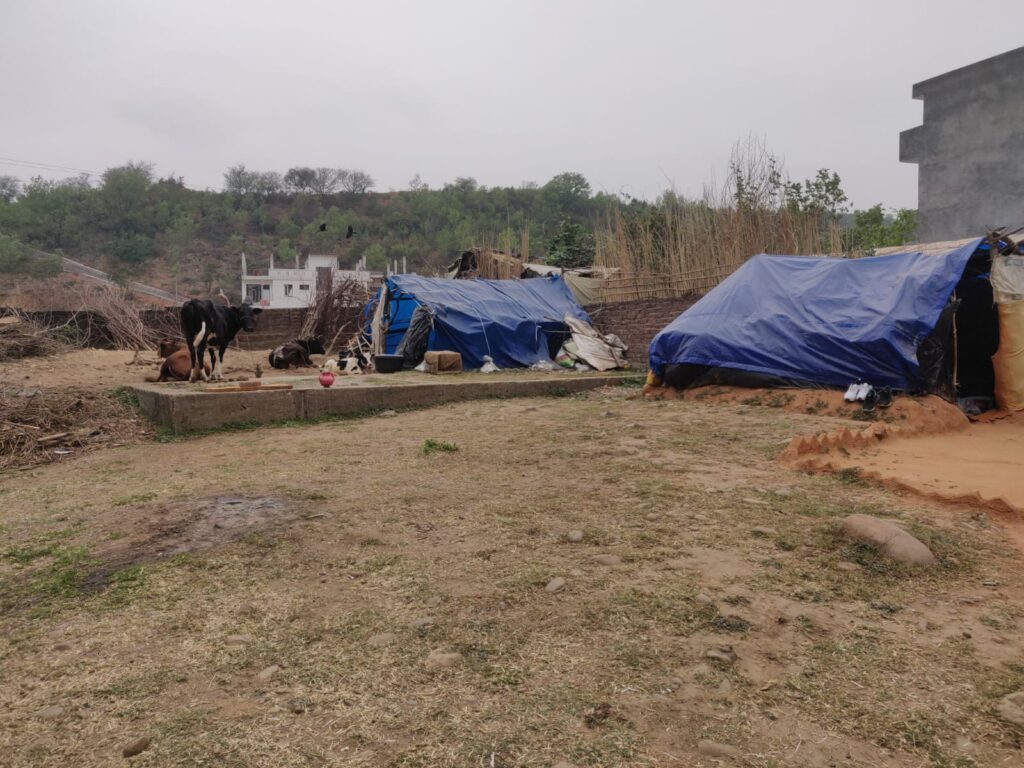
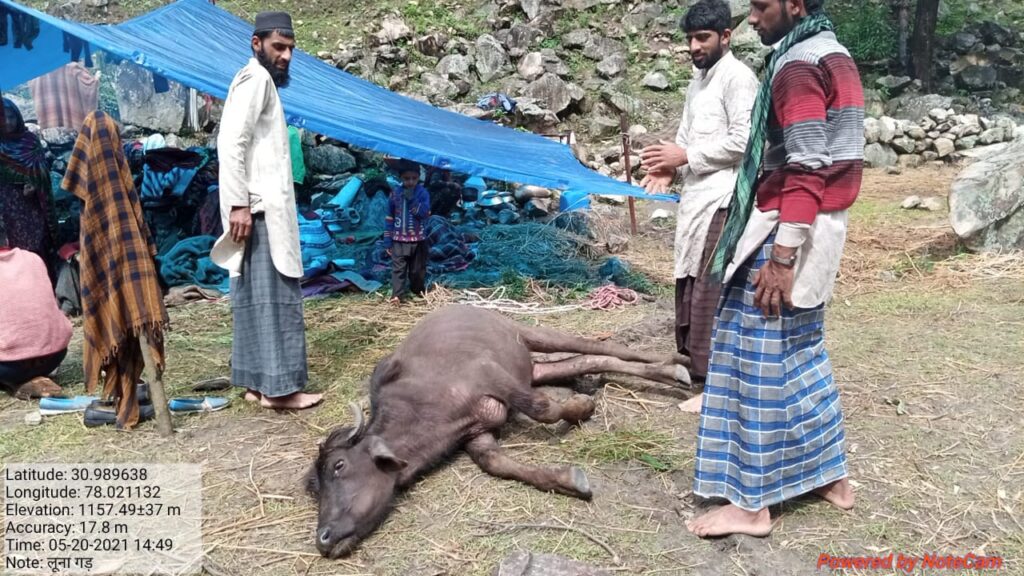
The lack of political representation of these communities within the Panchayati Raj system has isolated them from livelihood schemes such as MGNREGA. It has also prevented them from claiming rations through the Public Distribution System, and in the absence of insurance schemes, from collectively demanding compensation for their losses. “The Forest Department did not even pursue the bare minimum to help us withstand the income loss,” says Mohamad Sharafat, a Van Gujjar. “It arbitrarily distributed ration kits amongst a few political elite, while our buffaloes starved while waiting for the expected fodder.” On the other hand, the Bakarwals of Jammu and Kashmir were forced to weather the pandemic without the chance of fully recovering from the lockdown imposed post abrogation of Article 370 in the Union Territory.
It is clear that this ready discrimination against pastoralists by the neoliberal State has economic implications for the community. However, in a region where humans share intricate relationships with the environment, they have deep ecological consequences as well.
The State is Missing the Ecological Benefits of Pastoralism
Government agencies—especially the Forest Department—falsely pitch nomadic pastoralism as antithetical to biodiversity protection, leading to the detrimental exclusion of these communities’ traditional knowledge from climate change policy.
The State encourages large scale private extraction in ecologically sensitive zones like the Himalayas. As a solution to its own systemic excesses, it instead targets symbiotic subsistence economies—like those of pastoralists’—via its conservation policies.
For example, nomadic pastoralism by these Himalayan tribes has historically ensured the seasonal maintenance and regrowth of grasslands. Rotational grazing practices used by the communities regulate the frequency of forest fires by limiting excess growth of forests, creating organic buffer zones [5].
Anthropologists such as Bhasin (2013) have further identified how the nomadic pastoralists of the Himalayas efficiently use seasonally abundant natural resources, increase soil fertility of agrarian lands when their flock inhabit them during winters, and check the growth of invasive species by weeding them out [6]. Soil and water conservation and ground water rejuvenation are seasonally undertaken by these nomads as an unpaid livelihood strategy, ultimately benefiting foothill biomes and human habitats.
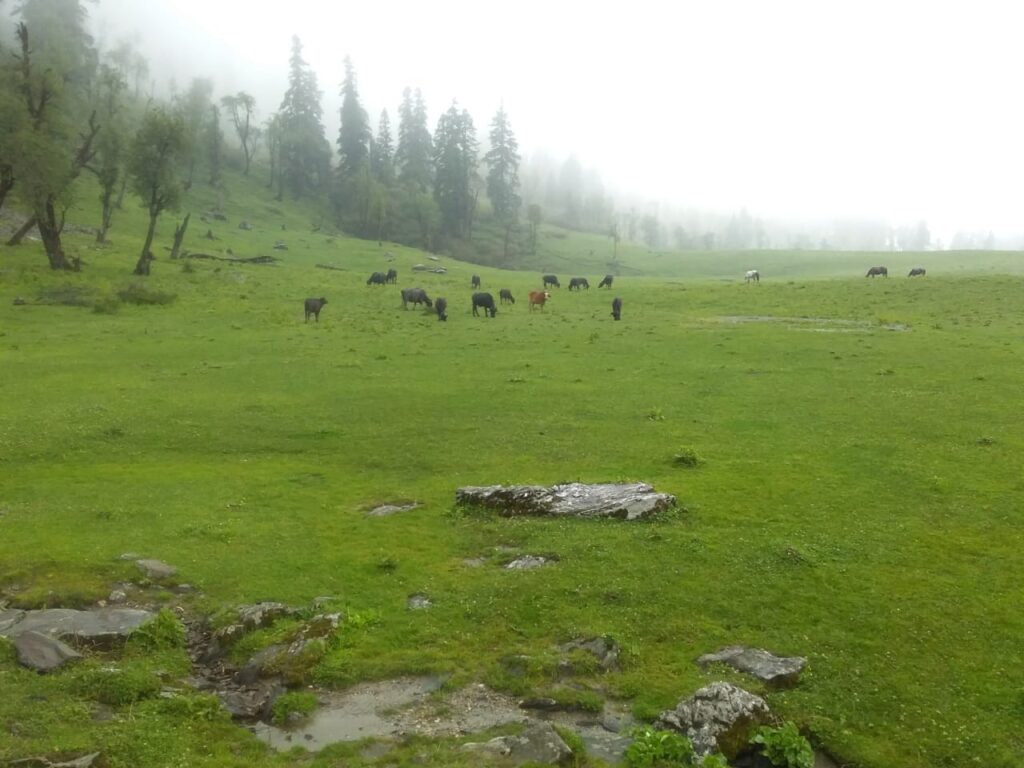
“While returning to the winter homestead, the Bakarwals clear out excess weeds and vegetation in the hills and repair watering holes near the pastures,” says Zeeshan Chowdhary from Raika village in the outskirts of Jammu. “This helps not only their flock, but also makes easier trails for buffaloes owned by local dairy farmers to follow.” Moreover, as summer approaches, there is reduced risk of forest fires in the hills as most Himalayan nomads excise away dead wood and dried shrubs, as well as lop overgrown species to allow fresh growth in spring.
In light of the clear ecosystem benefits the nomads enable, restricted access to forests and grazing bans by the Forest Department has only backfired on the Himalayan regions they graze in. The inhibition towards grazing has fostered a policy for growing monocultures, afforested through the Compensatory Afforestation Fund Management and Planning Authority by the state’s Forest Department. The prohibition on rotational grazing and migration has also led to a rise in exotic species, coupled with increased risks of forest fires and reduced forest soil fertility [7]. The drying up of water bodies maintained by the nomads in plains during the summer accentuates human wildlife conflict. Wild animals begin frequenting urban habitats seeking water and food previously provided by transhumance practices. Amidst all of this, the Forest Department utilises surveillance techniques through drones and camera traps to pin the blame of lopping and overgrazing on these communities, in a bid to constantly restrict them to specific zones.
And so, as the neoliberal economy, lax bureaucratic and political will, and majoritarian societal forces come together to eradicate pastoralist lifestyles as well as degrade the Himalayan ecosystem, a climate unjust paradigm prevails for such nomads.
A “Public” Policy in the Himalayas Sans Pastoralists?
The Forest Rights Act, 2006 was considered a progressive legislation—if implemented in its true spirit, it would have allowed for a dignified livelihood for communities traditionally tied to nature, as well as their inclusion in forest governance. However, administrative malfeasance and deliberate political decisions have excluded the Van Gujjars and Bakarwals from communitarian claims over their pastures for grazing and access to forest produce coupled with opportunity to reside therein.
In a bid to rid the landscape of these forest dwelling pastoralists, the Forest Department has consistently cited the communities as threats to the ecosystem either as encroachers or poachers. Even during the peak of the pandemic in 2020, several threats of summary eviction from Van Gujjar deras (or temporary settlements) were pursued, without any requisite notice as per Section 61-A of the Indian Forest (Uttaranchal Amendment) Act, 2001 in Shyampur, Ramgarh, and Shivpuri ranges. As a result, the community was denied the basic dignity of a residence during a pandemic that required citizens to stay indoors.
Meanwhile, despite the extension of the FRA into Jammu and Kashmir after its declaration as a Union Territory in August of 2019, the implementation of the Act remains far from desired for nomadic pastoralists therein. Similarly, the Bakarwal pastoralists face a series of evictions pursued by the Forest Department in complete violation of the Supreme Court’s 2019 order in the Wildlife First case, which stayed further evictions of forest dwellers, until the review of FRA claims across all states is completed.
Gujjar community is being evicted from their homes.
What are two major parties – @JKNC_ and @jkpdp, doing about this?
They are contesting DDC elections and fighting over seat sharing despite in alliance.pic.twitter.com/kcCQQ49sRq
— Fahad Shah (@pzfahad) November 15, 2020
The Centre’s pandemic policy indicates an acute bias in favour of settled populations, which simultaneously penalises mobile populations like the Himalayan pastoralists. The excessive powers given to the Forest Department during the lockdown, and subsequent restrictions placed on pastoralists, left the communities fending for themselves for much of the pandemic.
To preserve the identity of these nomadic pastoral tribes and the ecological balance they uphold, one needs to extend the principle of justice and dignity intrinsic to policymaking to these communities as well. In order to discard the colonial lens of ‘backwardness’ when governing over these tribes, it is crucial that members of the community are included in policy formulation too.
While enforcing policies to stop the spread of COVID-19, administrators should also be empathetic and push for greater decentralisation and flexibility within institutions. More than ever, there is an urgent need to extend the Welfare State to these communities, so that they have equitable access to public resources, and so nomadic children can be protected against further risks to their lives and futures.
Finally, the state needs to accelerate the implementation of the Forest Rights Act in Jammu and Kashmir and Uttarakhand, to recognise the historic communitarian ownership of natural spaces by the Van Gujjars and Bakarwals. Policies that uphold the right to livelihood of the Bakarwals and Van Gujjars, and preserve their traditional wisdom too, would only benefit both Himalayan ecology and economy at large.
Featured image: the Bakarwals of Jammu and Kashmir, photographed at Rajouri district by Paul La Porte. | via Wikimedia Commons.
[1] Gooch, P. (1992). Transhumant Pastoralism in Northern India: The Gujar Case, Nomadic Peoples, No. 30, pp. 84-96.
[2] Ramnath, V. (1975). Sedentarization of the Gujjars: A report of survey made in Garhwal Himalayas, Development of Tribal Areas in the Hill Areas of North Western U.P., Journal of the Lal Bahadur Shastri National Academy of Administration.
[3] Scott, J. (1998). Seeing Like a State: How Certain Schemes to Improve the Human Condition have failed. Yale University Press: New Haven.
[4] Sanyal, K. (2007). Rethinking Capitalist Development: Primitive Accumulation, Governmentality and Post colonial Capitalism. Routledge: New Delhi and London.
[5] Nasrat, R., Pattanaik, B.K., and Farooquee, N.A. (2011). Adaptation and Coexistence of Van Gujjars in the Forests: A Success Story, 13th Biennial Conference of the International Association for the Study of the Commons (IASC), Hyderabad, India. Available at: http://dlc.dlib.indiana.edu/dlc/bitstream/handle/10535/7314/1400.pdf?sequence=1&isAllowed=y
[6] Bhasin, V. (2013). Pastoralists of Himalayas, Journal of Biodiversity, 4:2, pp. 83-113, DOI: 10.1080/09766901.2013.11884746.
[7] Ramprasad, V., Joglekar, A., and Fleischman, F. (2020). Plantations and pastoralists: afforestation activities make pastoralists in the Indian Himalaya vulnerable. Ecology and Society, 25(4):1., https://doi.org/10.5751/ES-11810-250401



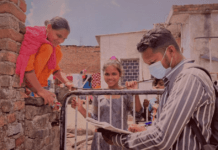


[…] Indian transhumant pastoralist communities—the Van Gujjars, the Bakarwals, and the Raikas. Click here for a primer on pastoralism through the pandemic, here for part two on the Van-Gujjar community, and here […]